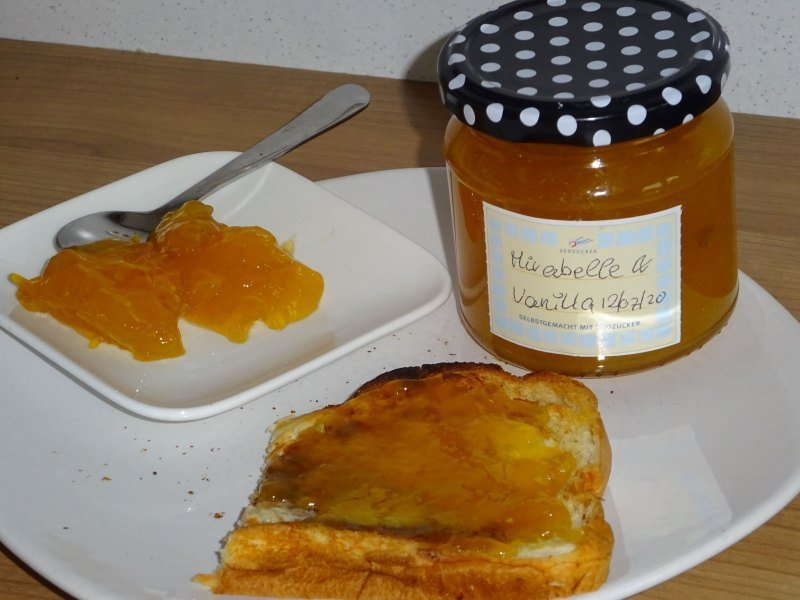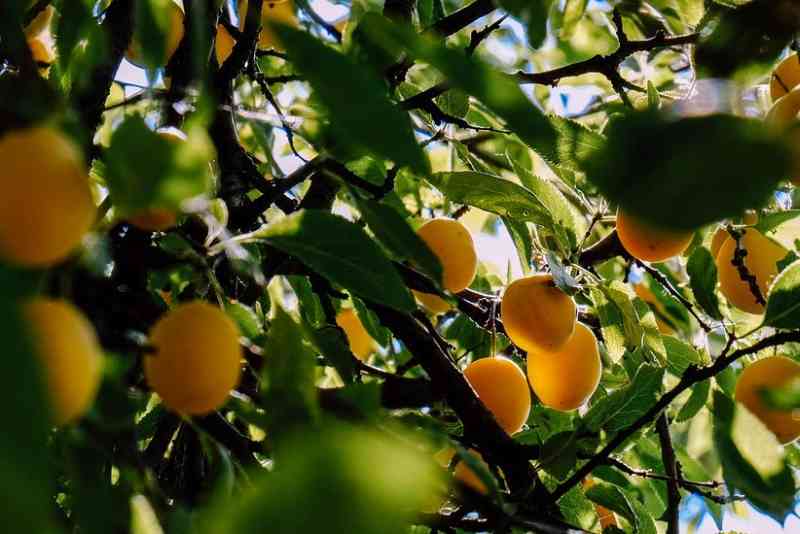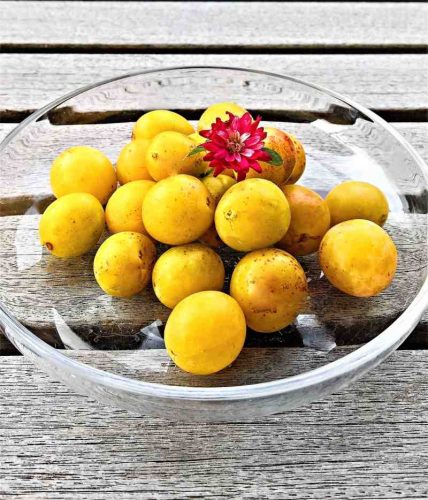Recently, while strolling through the woods, I discovered a wild Mirabelle tree loaded with ripe, golden fruit. I ate as much as I could and decided to come back the next day with a container to collect more Mirabelle to cook a very tasty jam. I thought about what special note I could add to this jam and decided on vanilla. That’s how I cooked my first ‘Mirabelle – Vanilla’ jam. The Mirabelle flavors combine excellently with a slight hint of vanilla.
I know it is hard to get Mirabelle, but once you have the opportunity, don’t miss trying out this recipe, you will have a tasty jam with bread and butter for breakfast, just like our grandmothers used to prepare.
Ingredients:
- 2.2 pounds Mirabelle
- 1 vanilla pod
- 2.5 cups of gelling sugar (2:1)
How to cook Mirabelle – Vanilla Jam:
- Wash the mirabelle plums, drain them well, and remove the stones. Puree the pulp.
- Cut the vanilla pod lengthways and press out the pulp (preferably with the back of a knife).
- Mix the mashed fruits, the vanilla pulp, the scraped-out vanilla pod, and the jam sugar in a large saucepan. Let the mixture sit and soak for 1 hour.
- Bring the mixture to a boil while stirring until it bubbles well. Now the cooking time begins! Let it boil for 4 minutes while stirring constantly.
- Take the pot off the stove, remove the vanilla bean.
- Fill the previously hot-rinsed jars to the brim with the mass and close them immediately with the screw cap.

Interesting facts about the Mirabelle:
The Mirabelle is a plum variety and therefore a stone fruit. It is spherical and has a diameter of 2-3 cm. Their waxy yellow skin often has fine red spots. The firm flesh is greenish-yellow to orange-yellow, particularly sweet and dissolves well from the stone. It is rounded and egg-shaped. It is believed that Mirabelle, which was first cultivated on the Anatolian Peninsula and in Northern Persia, is derived from a hybrid between a plum and a cherry plum, possibly also from a hybrid between a plum and a hawthorn. Mirabelle plums are extremely popular in Germany where they grow both wild and cultivated, primarily in the south and southwest.

The import of Mirabelle to the United States is restricted as the fruit has a protected origin designation. Mirabelles can be imported into the US only from Lorraine, France, making true Mirabelle Plums often hard to get in the US. However, in Tamalpais Valley, just north of San Francisco you will find trees dating back to the 1940s. They are still producing fruit in residential neighborhoods.
What is gelling sugar, do I need it to make jam?
Gelling sugar or jam sugar as it is called in the UK is sugar which already contains pectin. Pectin is a natural, vegan gelling agent and is found in almost all fruits. The peels of citrus fruits, but also apples and quinces are particularly rich in pectin. Low pectin is e.g. the strawberry. Sweet fruits generally have a lower pectin content than sour ones. Sugar is needed to make jam durable. The pectin binds the liquid and ensures that the jam sets when cooking. Gelling sugar also contains citric acid, which contributes to the durability of the jam. The advantage of using gelling sugar to cooking homemade jams is that it already contains all the components and significantly reduces the time it takes to make jams.
You can buy gelling sugar in three different varieties:
- Gelling sugar 1:1 contains sugar, citric acid, and pectins but no additional preservatives since the natural preserving effect of the sugar is fully given with the 1:1 ratio of fruit to sugar.
- Gelling sugar 2:1 contains sugar, pectin, citric acid, and the preservative sorbic acid. Here twice the amount of fruit is used as gelling sugar. The jam will be less sweet.
- Gelling sugar 3:1 contains sugar, pectin, citric acid, and the preservative sorbic acid. You use three times as much fruit in weight as you do Gelling Sugar. Here you’ll have the maximum fruit taste.
You can also cook jam without gelling sugar. Use normal table sugar. This trick only works for fruit types that naturally have a higher pectin content.
Depending on the water content of the fruit, jam without gelling sugar has to cook longer than normal jam, usually around 30 to 50 minutes. You will need to stir the jam constantly to prevent burning on the bottom of the pot and the formation of lumps.
 |
By: Andrea |

